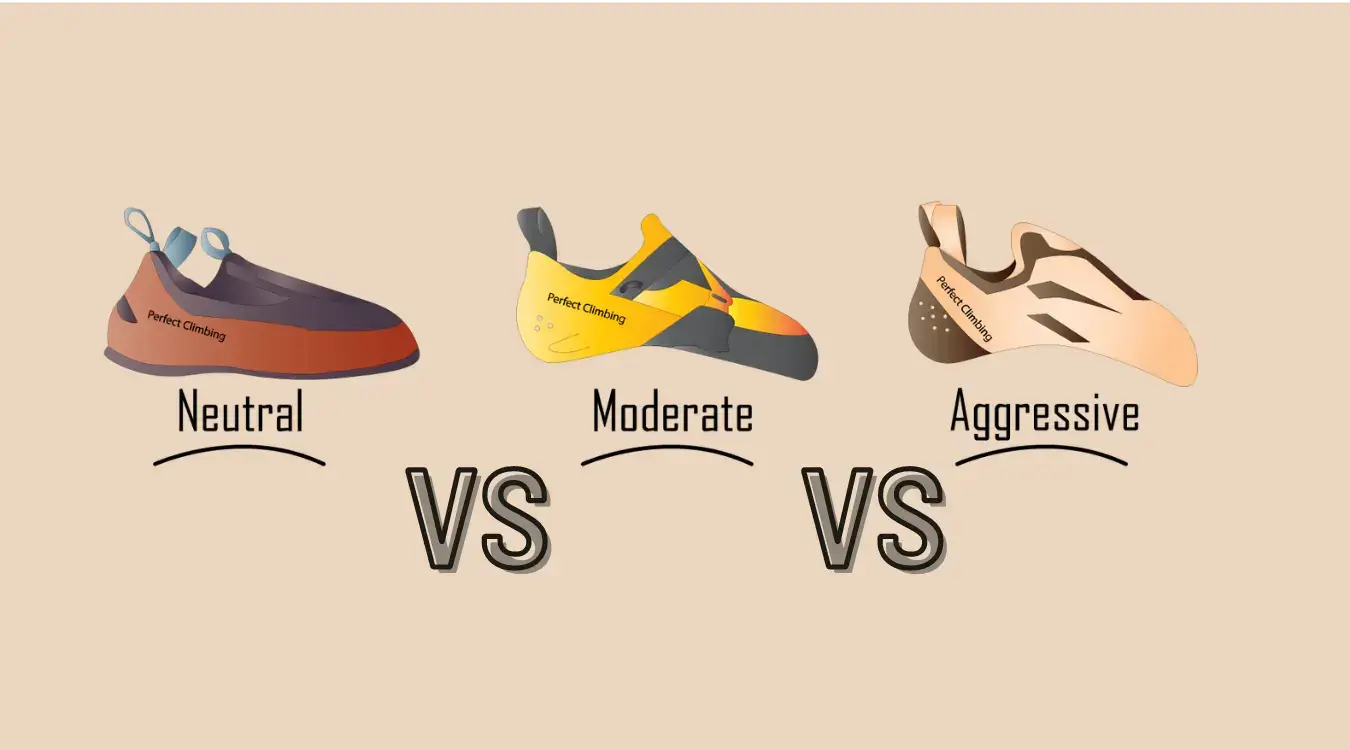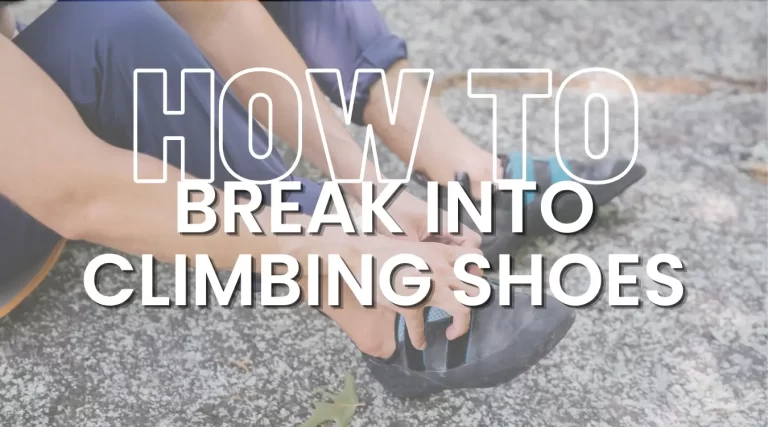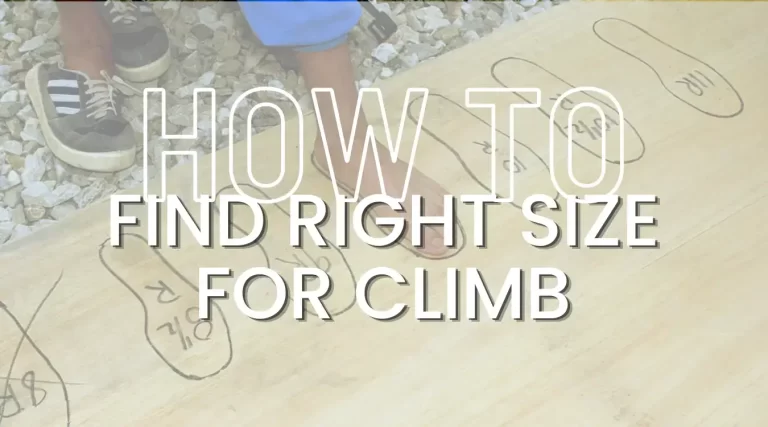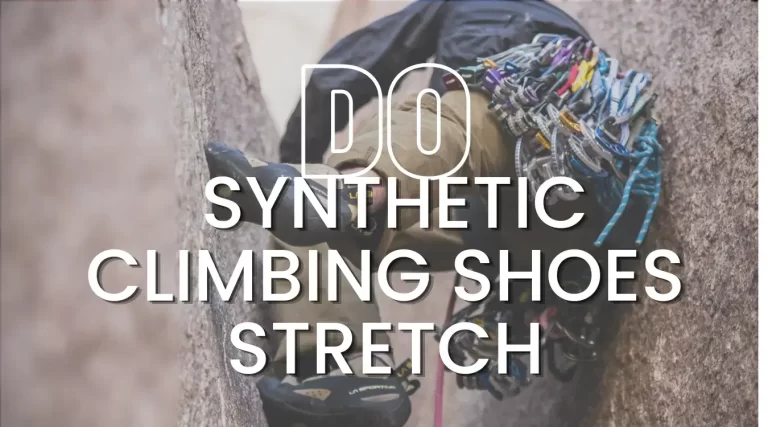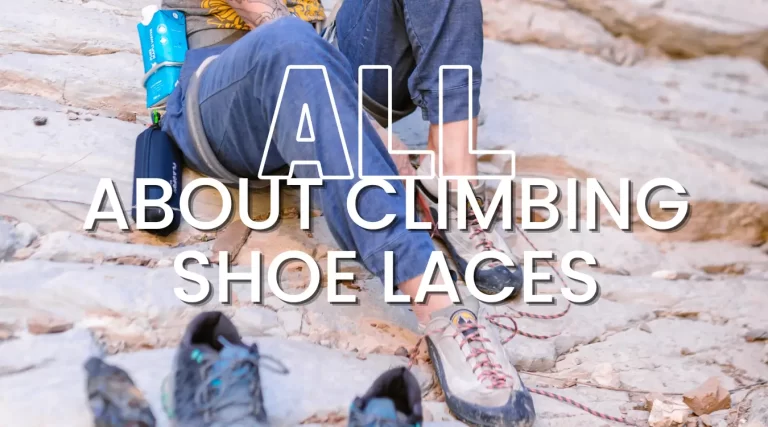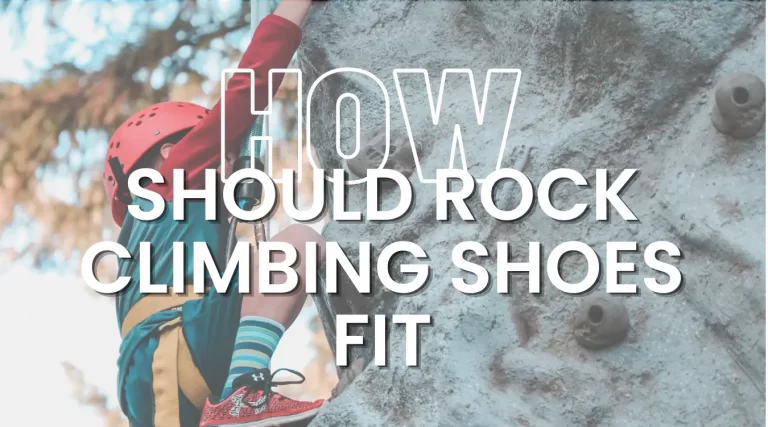The majority of climbing shoes may appear to be very identical to the casual observer. They are only made of rubber, fabric, and adhesive. I rue not. In addition to being quite complicated, climbing shoe pairs are unquestionably perhaps one of your most crucial tools.
The quality of your shoes to perform perfect steps can mean the difference between a lovely scent and a horrific weed wacker because they are the only thing holding you from hitting the mountain. Various shoes are accessible, and with many distinct models today, choosing your new set of shoes may be tricky. Here we have discussed difference between various types of shoes available in the market to give you an idea of what to look for in the shoes you are going to get.
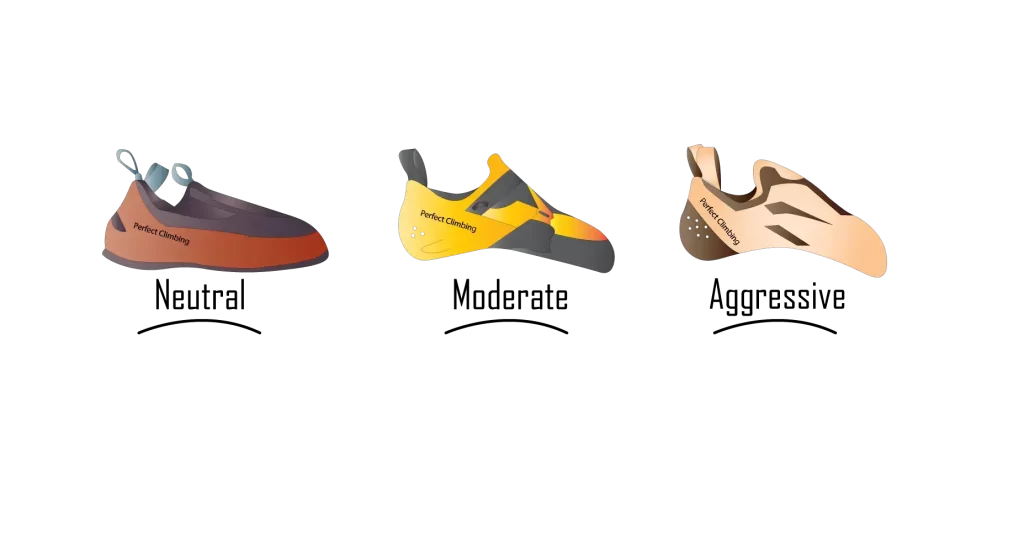
Read Best Beginners Climbing Shoes
Neutral Climbing Shoes
Comfort and Fit
When wearing neutral-colored shoes, your feet can relax in a flat, nearly proper position. This type of footwear works effectively in instances where relaxation trumps function. Learners typically prefer neutral climbing shoe pairs for such causes.
Neutral shoes frequently have a firmer sole and more robust outsole since your feet are at a wider angle than they are in an achievement shoe, which helps them sustain your pressure.
Neutral shoes offer a relaxed, flat profile with a comfortable fit. They are designed to allow your toes, especially the big toe, to lie flat, which provides ample support and all-day comfort.
Ideal for Beginners
These shoes are perfect for beginners, as they provide excellent support for your feet, making it easier to learn the ropes and build up your climbing skills. They are also great for indoor gym climbing and low-angle outdoor routes.
All-day Climbing
Neutral shoes are an excellent choice for all-day climbing adventures or multi-pitch routes where comfort is essential. While they might not excel in technical climbing, they are perfect for those long days when foot pain isn’t an option.
Pros
Cons
Moderate Climbing Shoes
These shoes go beyond simple relaxation. For fewer risks of falls climbs, professional hikers and sport climbing experts also utilize moderate shoes since the landscape suits their moderately slightly rounded smoother texture.
Compared to more strongly designed footwear, moderately designed footwear seem to smudge well and adapt well enough to derived terrain because their less abrasive system provides the heel of your foot with more significant interfacial interaction with the surface.
Read How to clean Climbing Shoes
Intermediate Climbers
Moderate shoes are a step up in terms of performance from neutral shoes. They feature a slightly downturned shape, which provides better precision and edging capabilities. This makes them ideal for intermediate climbers who want to tackle more challenging routes.
Versatility
Moderate shoes are versatile, as they can handle a wide range of climbing styles and terrain. Whether you’re climbing vertical faces, cracks, or slabs, moderate shoes provide the necessary balance between performance and comfort.
Technical Climbing
These shoes excel in technical climbing situations, providing enhanced sensitivity and precision on small footholds. They also offer better edging capabilities than neutral shoes, making them suitable for more challenging routes.
Pros
Cons
Aggressive Pair Of Climbing Shoes
In separate steep sports peaks or rocks, these shoes are often worn due to their considerably more slightly rounded curvature. They are typically less comfy and don’t work well for lengthy non-linear and non-expeditions.
Since they are designed for agility, they frequently have thicker leather and lighter bottoms than more moderate shoes. For precise placing on the smallest of stays, the force of an aggressive leather shoes would be directed directly into the forefoot.
You may also “grip” the surface with your forefoot and draw yourself in, thanks to the shoe’s curved design. It is crucial while climbing hilly inclines since your toes can help relieve some of the strain from your shoulders.
Advanced Climbers
Aggressive pairs of climbing shoes are designed for advanced climbers who need the highest level of performance. They feature a sharply downturned, asymmetrical shape that delivers precision, power, and control on steep and overhanging routes.
Precision and Power
The aggressive shape allows for precise foot placements and increased power transfer through the toes, especially the big toe. This enables climbers to tackle difficult moves on small holds, pockets, and steep terrain with ease.
Steep and Overhanging Routes
These shoes are ideal for steep and overhanging routes, where the downturned shape and tight fit provide the necessary grip and support. They may not be as comfortable as neutral or moderate shoes, but their performance benefits outweigh the comfort trade-off for climbers tackling demanding projects.
Pros
Cons
Key Factors to Consider
When choosing between neutral, moderate, and aggressive climbing shoes, it’s essential to consider several factors, including your climbing style, shoe material, fit, and closure system.
Climbing Style
Your climbing style plays a significant role in determining the right type of shoe for you. If you’re a beginner or prefer long, multi-pitch routes, neutral shoes offer the comfort and support you need. Intermediate climbers tackling more technical terrain will benefit from moderate shoes, while advanced climbers pushing their limits on steep, overhanging routes should opt for aggressive ones.
Shoe Material
Rock climbing shoe pairs come in various materials, including leather, synthetic, and lined or unlined. Leather shoes tend to stretch more and offer a more comfortable fit over time, while synthetic shoes maintain their shape and size better. Unlined shoes provide better sensitivity and precision, while lined shoes offer more comfort and durability.
Fit and Comfort
The fit of a climbing shoe is crucial for performance and comfort. A well-fitting shoe should be snug but not painfully tight. It should provide enough room for your big toe to move slightly, but not enough to slide around. Ensure that the heel fits securely and there are no pressure points that could cause discomfort or pain.
Closure System
Rock climbing shoes feature different closure systems, such as laces, Velcro, or slip-on designs. Lace up shoes offer the most customizable fit, while Velcro provides quick and easy adjustments. Slip-on shoes are convenient and often used for training, but may not provide the same level of support as other closure systems.
According to softness
Rock climbing shoes can be classified based on their stiffness or softness in addition to their shape. Soft shoes generally provide more sensitivity and flexibility, while stiff shoes offer more support and edging capabilities. Here’s a comparison of soft shoes in neutral, moderate, and aggressive climbing categories:
Soft Neutral Climbing Shoes
Characteristics: Soft neutral rock climbing shoe pairs maintain the flat and relaxed profile of typical neutral shoes but feature a more flexible sole and upper. This combination provides comfort while enhancing sensitivity and allowing your foot to adapt more easily to different footholds.
Best Uses: Soft neutral shoes are well-suited for beginner climbers, gym climbing, slab routes, and crack climbing, where increased sensitivity and flexibility can be beneficial.
Soft Moderate Climbing Shoes
Characteristics: Soft moderate shoes retain the slightly downturned shape of moderate shoes, but with a more pliable sole and upper. This design offers a balance between performance and comfort, providing the sensitivity and adaptability of soft shoes while maintaining the precision and edging capabilities of moderate shoes.
Best Uses: Soft moderate shoes are versatile and suitable for a variety of climbing styles, including vertical faces, cracks, slabs, and slightly overhanging routes. They’re an excellent choice for intermediate climbers who want a shoe that can handle various terrains while still offering a comfortable fit.
Soft Aggressive Climbing Shoes
Characteristics: Soft aggressive climbing shoe pairs feature the sharply downturned and asymmetrical shape but with a more supple sole and upper. This design provides the aggressive precision and power while allowing for increased sensitivity and flexibility on steep terrain.
Best Uses: Soft aggressive shoe pairs are ideal for advanced climbers tackling steep and overhanging routes, where sensitivity and adaptability are crucial. They excel in bouldering, sport climbing, and difficult routes that require precise foot placements and the ability to grip small holds and pockets.
| Climbing Shoe Type | Characteristics | Best Uses |
|---|---|---|
| Soft Neutral Shoes | Flat and relaxed profile, flexible sole and upper | Beginner climbers, gym climbing, slab routes, crack climbing |
| Soft Moderate Shoes | Slightly downturned shape, pliable sole and upper | Vertical faces, cracks, slabs, slightly overhanging routes |
| Soft Aggressive Shoe | Sharply downturned and asymmetric, supple sole and upper | Steep and overhanging routes, bouldering, sport climbing, difficult routes |
According to the foot shape
When choosing between neutral, moderate, and aggressive climbing shoe pairs based on your foot shape, it’s essential to consider the specific characteristics of each type and how they align with your unique foot anatomy. Here’s a guide to help you select the right climbing shoe according to your foot shape within each category:
Narrow Feet
Neutral Shoes: For narrow feet, look for neutral shoes with a low-volume design and a slim fit. Brands like La Sportiva and Scarpa offer some models suitable for narrow feet.
Moderate Shoes: Opt for moderate shoes with a narrow or low-volume last. Tenaya and some La Sportiva models are known for catering to climbers with narrow feet in this category.
Aggressive: Choose aggressive shoe pairs with a slim, asymmetric shape designed for narrow feet. Some La Sportiva and Scarpa models are ideal for narrow-footed climbers seeking such options.
Wide Feet
Neutral Shoes: Seek out neutral shoes with a wider, high-volume last. Brands like Evolv, Black Diamond, and some Five Ten models offer suitable options for climbers with wide feet.
Moderate Shoes: Choose moderate shoes with a wider fit to accommodate your foot shape. Look for brands like Evolv and some Black Diamond models known for their wide-fitting shoes.
Aggressive: For aggressive ones, opt for models with a wider, asymmetric shape designed for wide feet. Some Evolv and Butora models cater to climbers with wide feet in the aggressive category.
High Arches
Neutral Shoes: If you have high arches, look for neutral shoes with more pronounced arch support or a laced closure system for customizable fit adjustments.
Moderate Shoes: Choose moderate shoes with a pre-shaped midsole or additional arch support. Lace up shoes can provide more comfort and customization for climbers with high arches.
Aggressive: Seek out models with a suitable arch support that can accommodate your foot shape without compromising performance.
Low Arches / Flat Feet
Neutral Shoes: Climbers with low arches or flat feet should opt for neutral shoes with a flatter last and minimal arch support.
Moderate Shoes: Choose moderate shoes with a flatter sole profile and adequate support for low arches.
Aggressive Shoe Options: Opt for aggressive options that provide sufficient support and comfort for flat feet without excessive pressure on the arch area.
Morton’s Toe (Long Second Toe)
Neutral Shoes: If you have Morton’s Toe, look for neutral shoes with a more symmetrical toe box to accommodate your unique toe length.
Moderate Shoes: Choose moderate shoes with a roomy toe box that allows your toes to rest comfortably without excessive pressure on the longer second toe.
Aggressive Shoe Pairs: For aggressive shoe options, opt for models with a more accommodating toe box, ensuring there’s enough room for your toes without compromising performance.
Remember to try on various models and brands within each category to find the perfect fit for your foot shape. Testing the shoes in a climbing-specific environment will help ensure they provide the support, comfort, and performance you need for your climbing adventures.
| Foot Shape | Neutral Shoes | Moderate Shoes | Aggressive Shoe |
|---|---|---|---|
| Narrow Feet | La Sportiva, Scarpa (low-volume) | Tenaya, La Sportiva (narrow last) | La Sportiva, Scarpa (slim, asymmetric) |
| Wide Feet | Evolv, Black Diamond, Five Ten | Evolv, Black Diamond | Evolv, Butora (wider, asymmetric) |
| High Arches | Pronounced arch support, laces | Pre-shaped midsole, laces | Suitable arch support |
| Low Arches/Flat Feet | Flatter last, minimal arch support | Flatter sole profile | Support and comfort for flat feet |
| Morton’s Toe | Symmetrical toe box | Roomy toe box | Accommodating toe box |
What Should I pick as a beginner in Neutral Vs Moderate Vs Aggressive climbing Shoes?
As a beginner climber, it’s generally recommended to start with neutral climbing shoes for the following reasons:
- Comfort: Neutral shoes have a flat and relaxed profile that allows your feet to maintain a natural position, providing more comfort during extended periods of wear. This is especially important for beginners who are still getting accustomed to climbing and the feel of your shoes.
- Support: Neutral shoes offer excellent support, which helps build foot strength and develop proper climbing techniques. This support is crucial for beginners as they work on building their foundational climbing skills.
- Versatility: Neutral shoes are versatile and work well for various climbing styles, including slab routes, gym climbing, and crack climbing. As a beginner, you will likely be exploring different types of climbing to determine your preferences and strengths, making the versatility of neutral shoes ideal.
- Ease of Use: The comfort and support provided by neutral shoes make them more forgiving and easier to use for beginner climbers. They don’t require as much precision or foot strength as moderate or aggressive ones, allowing you to focus on learning techniques and building confidence.
While moderate shoes could also work for some beginners who are progressing quickly and looking to transition to more technical climbing, aggressive options are generally not recommended for beginners due to their tight fit, downturned shape, and focus on performance over comfort.
Conclusion
Choosing the right climbing shoes for climbing can significantly impact your climbing experience and performance. By understanding the differences between neutral, moderate, and aggressive shoes, you can make an informed decision that aligns with your climbing style and skill level. Always consider factors like material, fit, and closure systems when making your choice. With the right shoes, you’ll be well on your way to climbing success!
FAQs
1. Can I use the same shoes for indoor and outdoor climbing?
Yes, you can use the same shoes for both indoor and outdoor climbing. However, some climbers may choose to have a separate pair for indoor use to preserve the rubber on their outdoor shoes.
2. How do I know when it’s time to replace my climbing shoes?
You should consider replacing your shoes when the rubber starts to wear thin, there are holes in the toe area, or the shoes no longer provide adequate support and performance.
3. How do I clean my climbing shoes?
To clean your shoes, use a soft brush and water to remove dirt and debris. Avoid using harsh chemicals or soaking the shoes in water, as this can damage the materials.
4. Can I resole my climbing shoes?
Yes, many shoes can be resoled by a professional, which can extend their lifespan and save you money in the long run.
5. How should I store my climbing shoes?
Store your shoes in a cool, dry place away from direct sunlight. This will help maintain the rubber’s performance and prevent the shoes from becoming misshapen.
Overall Comparison
| Feature | Neutral Shoes | Moderate Shoes | Aggressive |
| Shape | Flat | More Downturned | Asymmetrical |
| Sole | Medium Thick | Stiffer | Stiff |
| Rubber | Sticky | Softer | Stickier |
